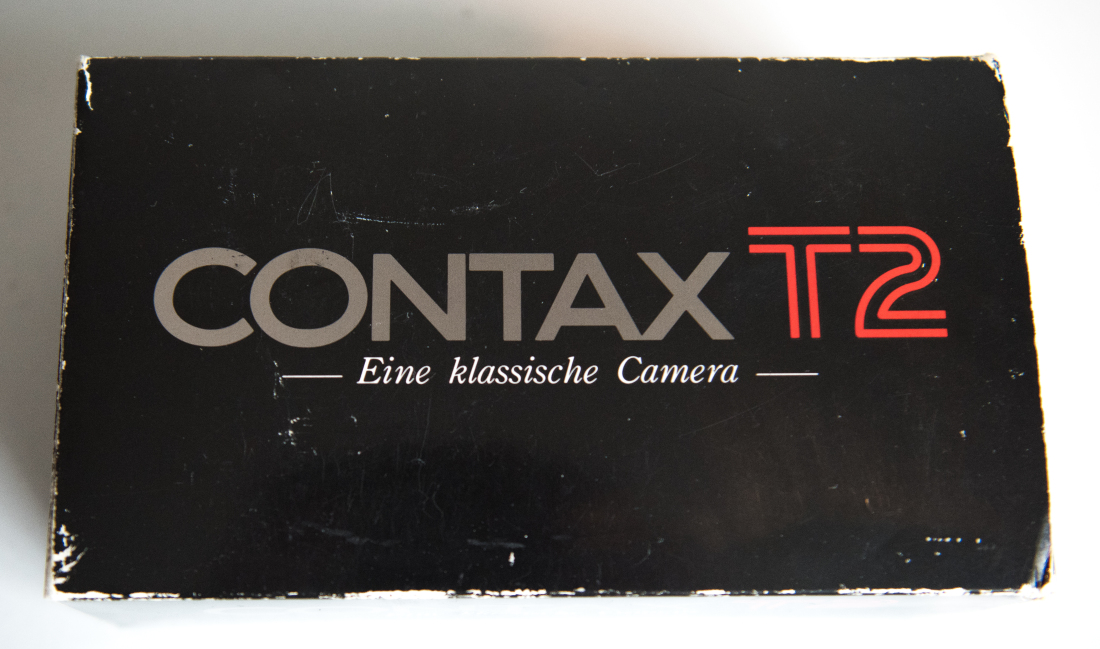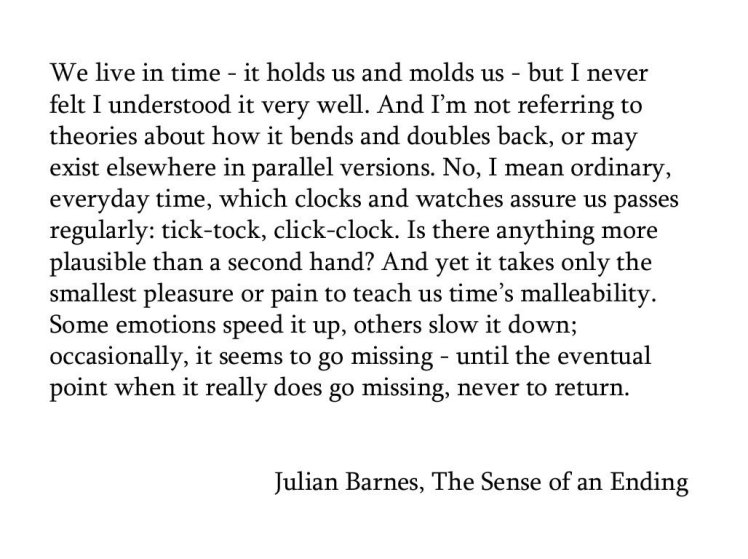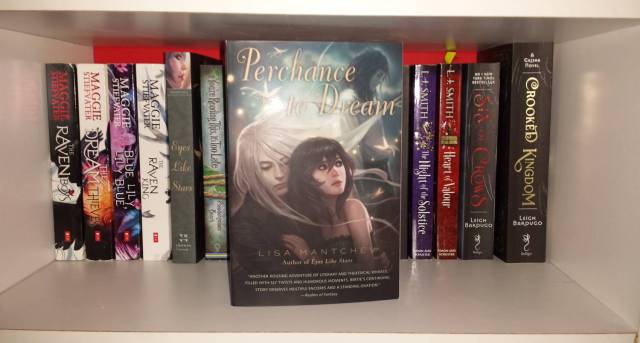In which we continue our perusal of the life and times of my 3x g. grandfather, Samuel Backler (1784-1870), tracing the birth and some deaths of his and Mary Pellatt’s children, and witnessing his metamorphosis from apothecary to tobacconist, along with a few brushes on the right side of the law at the Old Bailey.

A growing – and sometimes diminishing – family. As noted in my most recent post, Samuel Backler married Mary Pellatt on 30 November 1810 at St Andrew by the Wardrobe, the church which was amalgamated with St Ann Blackfriars after the Great Fire of 1666. St Andrew by the Wardrobe exists today, rebuilt within its Christopher Wren walls after destruction by bombing in the Second World War.
As can be seen in the extract above, it clearly wasn’t sufficient for there to be two witnesses to this marriage! To the left we see signatures of Apsley Pellatt, presumably Mary’s father, and S Backler (or could this be a ‘J’?) and M Backler, possibly Joseph, Samuels’ brother, and their sister Mary. Next we see ‘S Backler’, almost certainly Sotherton Backler, Samuel’s father. Underneath is J Backler Jnr – or is this an ‘S’? Could this be Samuel’s youngest sibling, 12 year old Sotherton? To the right are Apsley Pellatt Jnr (1791-1863), Mary’s brother, and another brother, Stephen Pellatt (1792-1839).
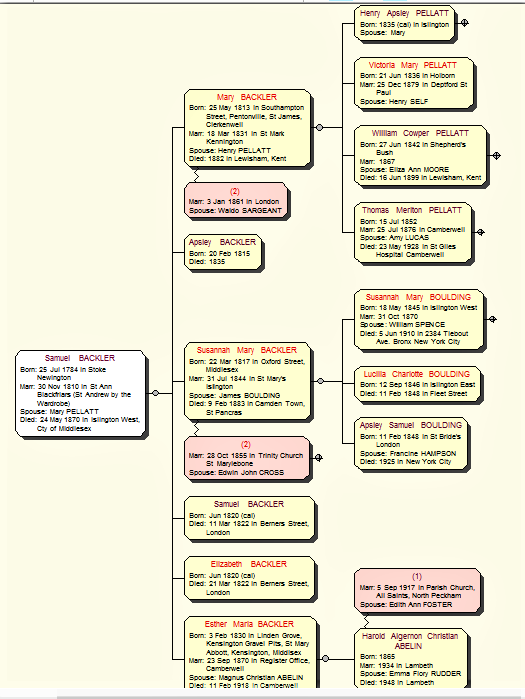 The slightly fuzzy tree on the left shows the birth of six children. Young Apsley Backler is something of a puzzle. I can find no record of his christening, nor of his death. Yet he appears in a family tree held at The National Archives (J66/10/43), linked to the case of Buxton v Pellatt, a dispute over inheritance and the Will of Susannah [Maberly] Langford. These papers contain a number of family trees, and I will probably draft a separate blog post about them. Meanwhile, it would have been logical for a child to be name Apsley, after Mary’s father. Did he exist? Any answers most welcome!
The slightly fuzzy tree on the left shows the birth of six children. Young Apsley Backler is something of a puzzle. I can find no record of his christening, nor of his death. Yet he appears in a family tree held at The National Archives (J66/10/43), linked to the case of Buxton v Pellatt, a dispute over inheritance and the Will of Susannah [Maberly] Langford. These papers contain a number of family trees, and I will probably draft a separate blog post about them. Meanwhile, it would have been logical for a child to be name Apsley, after Mary’s father. Did he exist? Any answers most welcome!
First born was Mary Backler (1813-1882), in 1813. I have looked at her marriage to her cousin, Henry Pellatt, in a previous blog. Her birth on 25 May 1813 was registered on 21 June 1816 at Dr. Williams’ Library, the repository for non-conformist births, where many Pellatt children’s births were registered. Witnesses were John Cribb, a Pellatt ancestor, and Mary Pellatt, presumably Mary (nee) Maberly, Mary (Pellatt) Backler’s mother. Lots of Mary’s! I have recently discovered a real puzzle concerning the births of the children of Mary and Henry’s first-born, Henry Apsley Pellatt. Another blog post is needed!
Next appears the mysterious Apsley Backler…mentioned in a series of family trees, all related to the Will of Susannah Langford, sister of Mary Pellatt, wife of Samuel. I have no further information about him.
Susannah Mary Backler followed on 22 March 1817, born in ‘Oxford Street’, presumably at the 71 Berners Street address where records show Samuel Backler and his wife Mary lived for some years, not far from Samuel’s brother Joseph, the stained glass artist, in Newman Street. Susannah was my 2x great grandmother and I will devote future blog posts to her and her marriage to the elusive James Boulding. I have never found a christening record for her.
Samuel Backler and Elizabeth Backler, presumably twins, appeared in 1820, although there appears to be no christening record for them either. Sadly, both were to die within 10 days of each other in 1822, to be interred in Bunhill Fields Cemetery.
Very much later, the youngest child of Samuel and Mary Backler was Esther Maria Backler, whose arrival on 3 February 1830 was very near the time when Samuel was to face bankruptcy, and his nephew Joseph to be transported to Australia. Esther Maria was baptised at Holland Road Independent Chapel in the Brixton Road in March 1830, the family’s address given as Linden Grove, Kensington Gravel Pits. Samuel’s occupation was now a tobacconist. This address, near what is now Notting Hill Gate, was in the early 19th century a favoured area, away from the city, and home to many artists. The picture below ((c)Victoria & Albert Museum), is entitled The Mall, Kensington Gravel Pits. It is by the artist William Mulready, and dated around 1811-12.
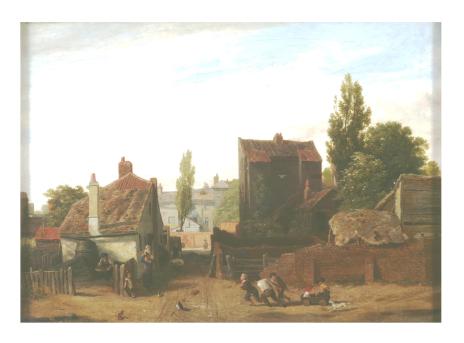
Esther Maria lived with her parents after her sisters’ marriages, and was only to marry Magnus Christian Abelin in 1870, just months after the death of her father Samuel. She appears to have been the dutiful younger daughter, living with and caring for her parents in their later years.
Crime and Punishment: Back at Berners Street, off Oxford Street, the early years of the family saw them feature as the victims of some cases at The Old Bailey.
As a first example, I make an assumption (in the absence of an address) that the report below of ‘Elizabeth Butt: simple grand larceny, 18th September, 1816’ refers to Samuel and Mary Backler. 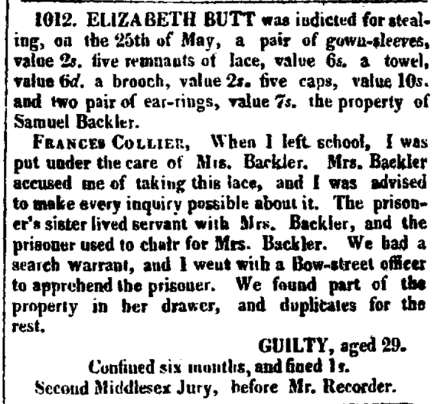 It is downloaded from the following url, and is reproduced from the Old Bailey Online Project. We have already seen examples of how helpful this project is, in stories about young Joseph Backler’s uttering of forged cheques. 1816https://www.oldbaileyonline.org/images.jsp?doc=181609180085
It is downloaded from the following url, and is reproduced from the Old Bailey Online Project. We have already seen examples of how helpful this project is, in stories about young Joseph Backler’s uttering of forged cheques. 1816https://www.oldbaileyonline.org/images.jsp?doc=181609180085
Hannah Barry – transportation for 14 years: On safer ground, in terms of location and participants, we find the case of Hannah Barry and Mary Murphy, Theft and receiving stolen goods, trial proceedings on 1 November 1824.
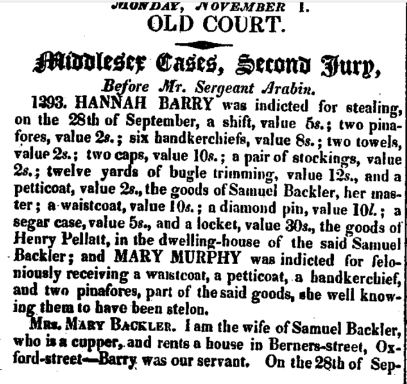 As seen on the left, the case began with a summary of items alleged to have been stolen by Hannah Barry, servant to Samuel and Mary Backler in their rented home in Berners Street. The evidence included statements by 12 year old Mary Backler’s cousin Henry, living with the family, and later to marry oldest daughter Mary, as described in a previous post. Following Mrs Backler’s statement that she had ‘missed property’, she said she had ‘sent for Craig, who searched her boxes and found a variety of property’. The rest of the case was as follows (image and text downloaded from: https://www.oldbaileyonline.org/browse.jsp?id=t18241028-140-defend1298&div=t18241028-140#highlight):
As seen on the left, the case began with a summary of items alleged to have been stolen by Hannah Barry, servant to Samuel and Mary Backler in their rented home in Berners Street. The evidence included statements by 12 year old Mary Backler’s cousin Henry, living with the family, and later to marry oldest daughter Mary, as described in a previous post. Following Mrs Backler’s statement that she had ‘missed property’, she said she had ‘sent for Craig, who searched her boxes and found a variety of property’. The rest of the case was as follows (image and text downloaded from: https://www.oldbaileyonline.org/browse.jsp?id=t18241028-140-defend1298&div=t18241028-140#highlight):
WILLIAM CRAIG . I am an officer. On the 28th of September I searched three boxes, which Mrs. Backler pointed out to me; the prisoner was present; and before I searched them, I asked her if she knew anything of a diamond pin, and a locket which were lost; she denied it at first, and then said she had found the pin, but knew nothing of the locket; she went up stairs with us, one of her trunks was open, and another locked; the third was a small tea chest. I found two stiffners in her pocket; in the open trunk was the trimming, and several things, and in the other trunk several caps and articles of linen; and in her tea chest, I found the diamond pin – she said she knew it was in some of her boxes, but could not tell which. I forget whether the tea chest was locked. I went to Murphy’s house with a warrant, and found a waistcoat, a petticoat, and other things; she was not at home, but her husband was. I afterwards saw her, and she said she had bought them of different people in the street.
Cross-examined by MR. PHILLIPS. Q. You do not know that to be a diamond pin – A. I am told that it is.
MR. HENRY PELLATT . I lived at the prosecutor’s house. This diamond pin and locket are mine, and the waistcoat. I missed the pin and locket on the 27th of September; I had seen them two or three days before, and had left them in a box unlocked.
Cross-examined. Q. Are there any children in the house – A. Yes, one of them is twelve years old. I had put the property among some fishing tackle.
COURT. Q. How long had you lived there – A. Three years. I wore the pin every day; the prisoner must have known it to be mine. I paid 13 l. for it about six months ago, to Mr. Fletcher, a lapidary, of Marlborough-street.
(Property produced and sworn to.)
BARRY’S Defence. The box which the things were found in is not mine – I had lent my mistress a trunk when she went into the country, and she gave me one of hers to put my things in. I never saw these things till they were found.
MRS. BACKLER. Two of the trunks belonged to her; some of the property was in them, and some in one which I had lent her, having had an accident with hers, and sent it to be repaired – the tea chest belonged to her, and was locked. and she produced the key of it after some hesitation.
MR. PELLATT re-examined. I have tried the pin, and know it to be a diamond.
BARRY-GUILTY. Aged 25.
Of stealing to the value 39 s. only .
Transported for Fourteen Years .
MURPHY – NOT GUILTY .
Hannah Barry was duly transported to Van Dieman’s Land (Tasmania) on The Providence, which left England in December 1825, arriving in Australia on 16 May 1826. I cannot firmly identify what happened to her in later years. Once again, the standard of proof in Old Bailey Trials might well raise eyebrows in more modern times!
And finally: there is another case about Harriet Bate, theft, on 3 July 1834. This date is after the disastrous events for the Backlers of 1830-31, which I will recount in my next post. The case involves theft by Harriet Bate of goods belonging to her master, Samuel Backler, Silversmith, of Bishopsgate Street. His wife Mary gives evidence, stating she is a staymaker. Is this ‘our’ Samuel and Mary, or another? I am not sure. The full report can be seen at: https://www.oldbaileyonline.org/browse.jsp?id=t18340703-106-defend680&div=t18340703-106#highlight
There is a reference in this case to ‘the prosecutor’s son’. If there really was an Apsley Backler, this reference could be to him; if it is not him, then this is probably not ‘our’ Samuel, as there was no other surviving son. I haven’t, though, been able to trace an alternative ‘Samuel and Mary’. Samuel Backler (born in Haverhill) and his wife Elizabeth appear in St Luke’s Parish in the 1841 and 1851 censuses, but he is shown as a Labourer, and I don’t think he is the same as the one in the court case…perhaps!
Moving on: In this post I have tried to give a brief flavour of what might be called the middle years for Samuel and Mary Backler. Alas, their fortunes were not due to prosper, as we will see in my next post, in which I will consider Samuel’s bankruptcy and its apparent impact on family relationships.
Share this:

